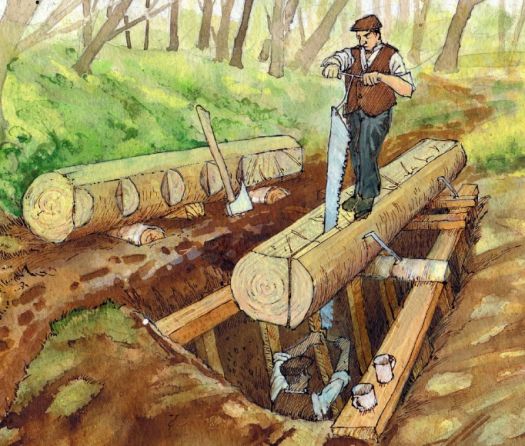Saw Pit
Saw pits are excavated trenches used for sawing timber with a traditional long-handled saw, called a "whipsaw." This was operated by two workers working in tandem. The worker positioned in the pit is commonly referred to as the "underdog," while the one on top is known as the "topdog." This method results in sawn planks used for various construction purposes, particularly in shipbuilding. Naturally, the method is only practiced in forested lands.
Saw pits could be found in back-country areas where trees needed to be processed before shipment — but these are also a common feature in manufacturing towns, villages and manor estates, normally located near untapped hinterlands thick with many untapped acres of woodland. The first step in creating a construction site is usually to build a saw pit, whcih can readily be prepared within a few days.
Supply
Individuals responsible for the task of making planks are called "sawyers." These play a vital role in the community, as the production of tools and structures relies on their skills. In a typical day, two men working in a saw pit can produce around 12 boards. A highly experienced person can operate the pit alone, with the saw's end weighted with a stone — but this reduces the daily output to approximately 4 or 5 boards. Nonetheless, for a character building a house alone, this pace is fast enough to cut boards that can be used to put up a small house in a summer.
As manufacturing towns grow in size, they construct expensive but effective water-powered mills, the need for saw pits diminishes, as these mills can produce up to 200 boards daily.
Labour
Saw pits rely on the assistance of woodcutters responsible for procuring the necessary wood and delivery. Though woodcutters are less likely to reside within a thorp, hamlet or larger settlement, their role is considered when calculating the overall population associated with a saw pit. Along with their families, the total consists of a modest 2 to 4 persons, including offspring.
Typically, the operation of a saw pit is a family affair, managed by parent-offspring teams or by siblings. This familial involvement adds another 2 to 5 individuals connected to the saw pit. Consequently, woodcutters and sawyers together, the total falls within a range of 4 to 9 persons.
See also,
Construction (sage study)
Half-timbered House (dwelling)
Hammer (symbol)
The Adventure
Type-7 Hex
